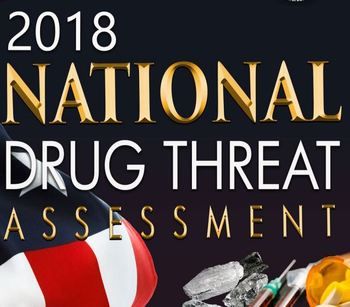
Publisher:
Bonnie King
CONTACT:
Newsroom@Salem-news.com
Advertising:
Adsales@Salem-news.com

~Truth~
~Justice~
~Peace~
TJP
Nov-03-2018 19:02

 TweetFollow @OregonNews
TweetFollow @OregonNews
DEA Releases 2018 National Drug Threat Assessment
Salem-News.comControlled prescription drugs remain responsible for the largest number of overdose deaths of any illicit drug class.
 |
(WASHINGTON, D.C.) - DEA Acting Administrator Uttam Dhillon today announced results of the 2018 National Drug Threat Assessment, which outlines the threats posed to the United States by domestic and international drug trafficking and the abuse of illicit drugs.
“This report underscores the scope and magnitude of the ongoing opioid crisis in the United States,” said Acting Administrator Dhillon.
“The information in the report represents data and critical intelligence from our law enforcement partners that was gathered over the past year.
"This report highlights the necessity of using all the tools at our disposal to fight this epidemic, and we must remain steadfast in our mission to combat all dangerous drugs of abuse.”
Among the key 2018 NDTA findings:
- Controlled prescription drugs remain responsible for the largest number of overdose deaths of any illicit drug class since 2001. These drugs are the second most commonly abused substance. Traffickers are now disguising other opioids as controlled prescription drugs to gain access to this market. (pages 1-10)
- Heroin-related drug-poisoning deaths almost doubled between 2013 and 2016. This has been exacerbated by the increased adulteration of heroin with fentanyl and other synthetic opioids. Heroin available in U.S. markets is primarily sourced from Mexico, where opium poppy cultivation and heroin production have both increased significantly in recent years. (pages 11-20)
- Of all opioids, the abuse of illicit fentanyl and other synthetic opioids has led to the greatest number of deaths in the United States. Fentanyl is increasingly available in the form of counterfeit prescription pills marketed for illicit street sales, and also sold by traffickers on its own, without the presence of other drugs. (pages 21-37)
- Mexican transnational criminal organizations, including the Sinaloa Cartel and Jalisco New Generation Cartel, remain the greatest criminal drug threat in the United States. The cartels are the principal wholesale drug sources for domestic gangs responsible for street-level distribution. (pages 97-99)
- National and neighborhood-based street gangs and prison gangs continue to dominate the market for the street sales and distribution of illicit drugs in their respective territories throughout the country. Drug trafficking remains the major income source for gangs. (pages 107-121)
Illicit drugs, as well as the transnational and domestic criminal organizations that traffic them, continue to represent significant threats to public health, law enforcement, and national security in the United States.
In 2016, approximately 174 people died every day from drug poisoning, outnumbering deaths by firearms, motor vehicle crashes, suicide and homicide. The opioid threat – including controlled prescription drugs, fentanyl and other synthetic opioids, and heroin – has had a devastating effect on our country.
In 2017, synthetic opioids such as fentanyl were involved in nearly 30,000 deaths, and from 2016-2017, Mexican heroin production grew by 37 percent.
Mexican cartels continue to make large quantities of cheap methamphetamine and deliver it to the United States through the Southern border. Seizures at the border increased from 8,900 pounds in 2010 to nearly 82,000 pounds thus far in 2018.
New enforcement priorities and programs implemented by the Justice Department and DEA will positively impact our communities and ultimately save American lives.
The Department of Justice has aggressively targeted the opioid crisis through robust manpower and funding, enabling federal law enforcement agencies like the DEA to conduct enforcement operations that target anyone violating the Controlled Substance Act.
In the past year, the Justice Department and DEA have engaged in new projects and initiatives to combat this scourge:
- established Operation Synthetic Opioid Surge, a new program seeking to reduce the supply of deadly synthetic opioids in high-impact areas and identify wholesale distribution networks and suppliers, both domestic and international;
- added additional heroin enforcement task forces;
- brought the indictments of two Chinese fentanyl traffickers, Jian Zhang and Xiaobing Yan;
- extradited Mexican drug traffickers;
- reduced the aggregate production quota;
- emergency scheduled all forms of illicit fentanyl;
- assigned special federal prosecutors to prosecute opioid-related investigations;
- authorized the hiring of more than 400 additional task force officers;
- and continue to work with the Chinese Government resulting in further controls being placed on fentanyl analogs, and related substances.
This month, the Justice Department announced new measures to dismantle transnational criminal organizations. The creation of a Transnational Organized Crime Task Force of prosecutors will coordinate the DOJ’s efforts to fight transnational organized crime.
The task force will focus on top transnational organized crime threats that include MS-13, Cartel de Jalisco Nueva Generacion, the Sinaloa Cartel, Clan del Golfo and Lebanese Hezbollah, a majority of which are included in DEA’s National Drug Threat Assessment.
The National Drug Threat Assessment provides a yearly assessment of the many challenges local communities face related to drug abuse and drug trafficking.
Highlights in the report include usage and trafficking trends for drugs such as prescription drugs, heroin, methamphetamine, cocaine, marijuana (cannabis) and the hundreds of synthetic drugs.
The assessment factors in information from many data sources such as drug seizures, drug purity, laboratory analyses, information on the involvement of organized criminal groups and data provided to DEA by state and local law enforcement agencies across the country.
The National Drug Threat Assessment can be accessed here.
Articles for November 2, 2018 | Articles for November 3, 2018 |


Salem-News.com:


googlec507860f6901db00.html
Terms of Service | Privacy Policy
All comments and messages are approved by people and self promotional links or unacceptable comments are denied.
[Return to Top]
©2025 Salem-News.com. All opinions expressed in this article are those of the author and do not necessarily reflect those of Salem-News.com.